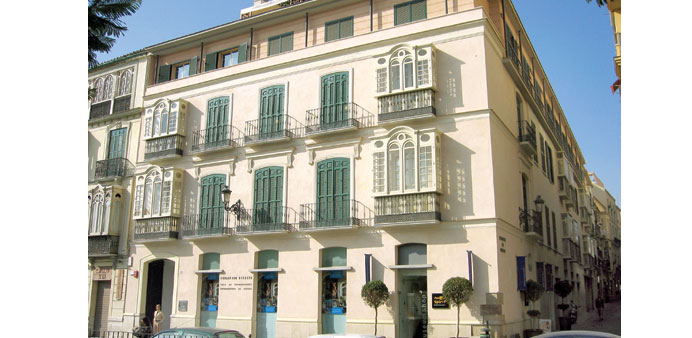By Raquel Miguel
Spanish artist Pablo Picasso needs no introduction: he produced so much art and is known in every corner of the globe. But Picasso the world-renowned artist grew up in the small Andalusian city of Malaga, where the young boy saw sand, sea, bulls and bullfights and popular figures he would never forget.
This year marks the 40th anniversary of the death of Picasso (1881-1973) and both museums that carry his art in Spain are celebrating their own special anniversaries: the one in Barcelona 50 years, and the Malaga one 10 years since being founded.
Picasso was born in Malaga and lived there until age 10. As a small child he loved to draw and scribbled on the sand in front of his home in La Merced square.
But his love of art also came from his father, also a painter. Jose Ruiz Blasco (Picasso’s full name was Pablo Ruiz Picasso) was also an art teacher. From a very young age, Picasso copied the artworks his father reproduced from other artists. The young boy was at ease in his father’s artistic circles.
“This is an aspect that is frequently forgotten. That he was born into an environment that was very favourable for him to develop his talent,” said Xavier Vilato, a grandchild of Dolores Ruiz Picasso, Picasso’s sister.
Vilato travelled to Malaga to attend the inauguration of the Picasso of Malaga: Work From His First Period, commissioned by Rafael Inglada, and the first of three exhibitions that the Picasso Museum in Malaga is organising to celebrate its 10th anniversary.
Vilato’s family and others close to the Ruiz-Picassos contributed works and objects from that era to the exhibition, funded by the Malaga museum and the Picasso Home museum, that transports viewers to his childhood.
Those early works which Picasso copied from his father and later liberated himself by doing his own work, are signed “Pablo Ruiz” or “Pablo R Picasso”. Later Picasso would drop the paternal surname completely.
It is interesting to see the Twilight in the Port of Malaga painted by Jose Ruiz Blasco in 1887 and which the young Pablo copied two years later, when he was barely eight years old.
It is also fascinating to see the pigeons that Picasso’s father painted so frequently. The father also liked the still-life mode, repeated time and time again by his son. Pigeons were of great symbolic importance for Picasso, Rafael Inglada said, to such a degree that he named his daughter “Paloma” (“pigeon” in Spanish and a fairly common name for females).
There are also bullfight paintings. This is because Picasso’s uncle took his nephew to a bullfight for the first time in Malaga. Bulls and bullfighting would be a theme that would stay with Picasso and become a metaphor for his enduring obsessions: virility and the fight against the passage of time and the inevitability of death. The exhibit also gathered works of the sea; a frigate capsizing that Picasso saw in an anonymous oil painting and drew two years later; fishermen and fish vendors as well as other popular figures: soldiers, nannies that Picasso saw as a child and continued to paint when he had achieved maturity as an artist.
“The portrait of a fisherman that he did when he was barely 14, or that of his aunt Pepa, with great realism, is impressive,” said Inglada. But so is a painting Picasso did of a fish vendor in 1899, when he was a 18-year-old and reveals his own caricature and sketching style, shaking off his father’s painting style.
The exhibit juxtaposes works by other artists, by Picasso’s father, and by Pablo Ruiz Picasso, showing how the child artist found himself and how his imagination developed.
In 1891 the Ruiz-Picasso family moved first to La Coruna and then to Barcelona, where a teenaged Picasso entered a fine arts school. At age 20 Picasso travelled on five occasions to Malaga, the last time around 1900-1901.
Experts feel that Picasso became freer when he travelled away from Barcelona.
“When he leaves Barcelona, far away from an academic setting, Picasso paints with greater freedom and is far more spontaneous,” said Malen Gual, a curator at the Picasso Museum in Barcelona. “The young man liberates himself, his brushstrokes are loosened, and he is much freer and more spontaneous.”
Legend has it that Picasso’s father Jose Ruiz, upon seeing how talented his son was, locked away his paints and paintbrushes and quit painting. That once Picasso became Picasso his father painted no more. What is known for certain is that when Picasso visited Malaga for the last time in early 1901, he never returned to that city.
“His family no longer lived there. He was young and he realised that he was living the future,” said the director of the Malaga Picasso Museum Jose Lebrero. The situation became more difficult later on because of the Spanish Civil War: “Picasso was a communist and pacifist and he did not want to return during the Franco regime,” Lebrero said.
The friend who travelled with Picasso on his final trip to Malaga, Carlos Casagemas, later committed suicide, and according to Inglada this was another factor that impinged on the artist not returning to his hometown.
He may have never returned after 1901 but Pablo Picasso’s spiritual connection to Malaga and Andalusia remained strong even in his later years in France, as evidenced in a verse he wrote in 1936.
“I was born from a white father and from a small glass of Andalusian life/I was born from a mother who was daughter of a 15-year-old mother born in Malaga/in the Percheles the beautiful bull that created in me a forehead crowned with jasmines.” (Pablo Picasso, 1936). — DPA

The house where Picasso was born is located at Merced Square in Malaga.


